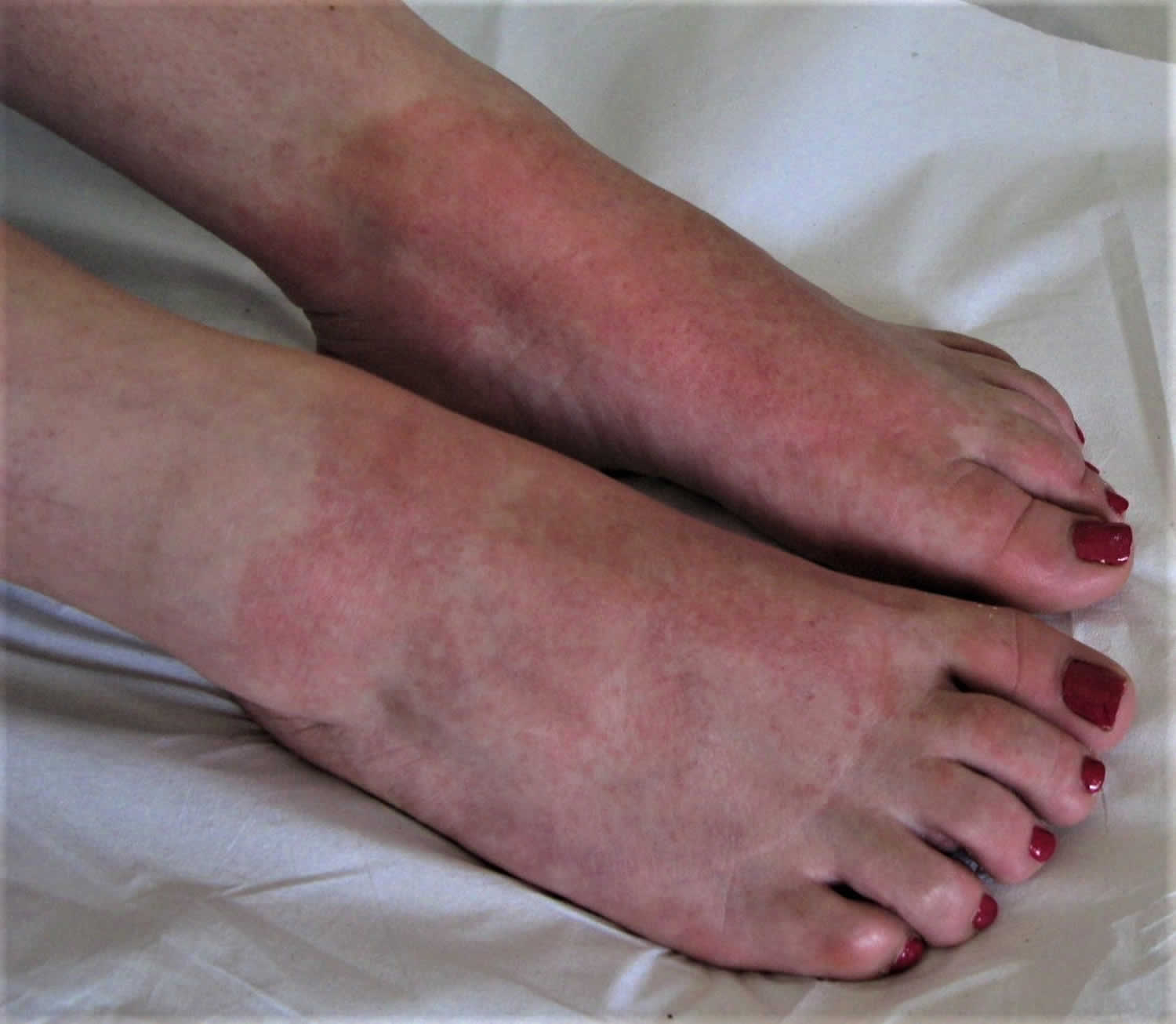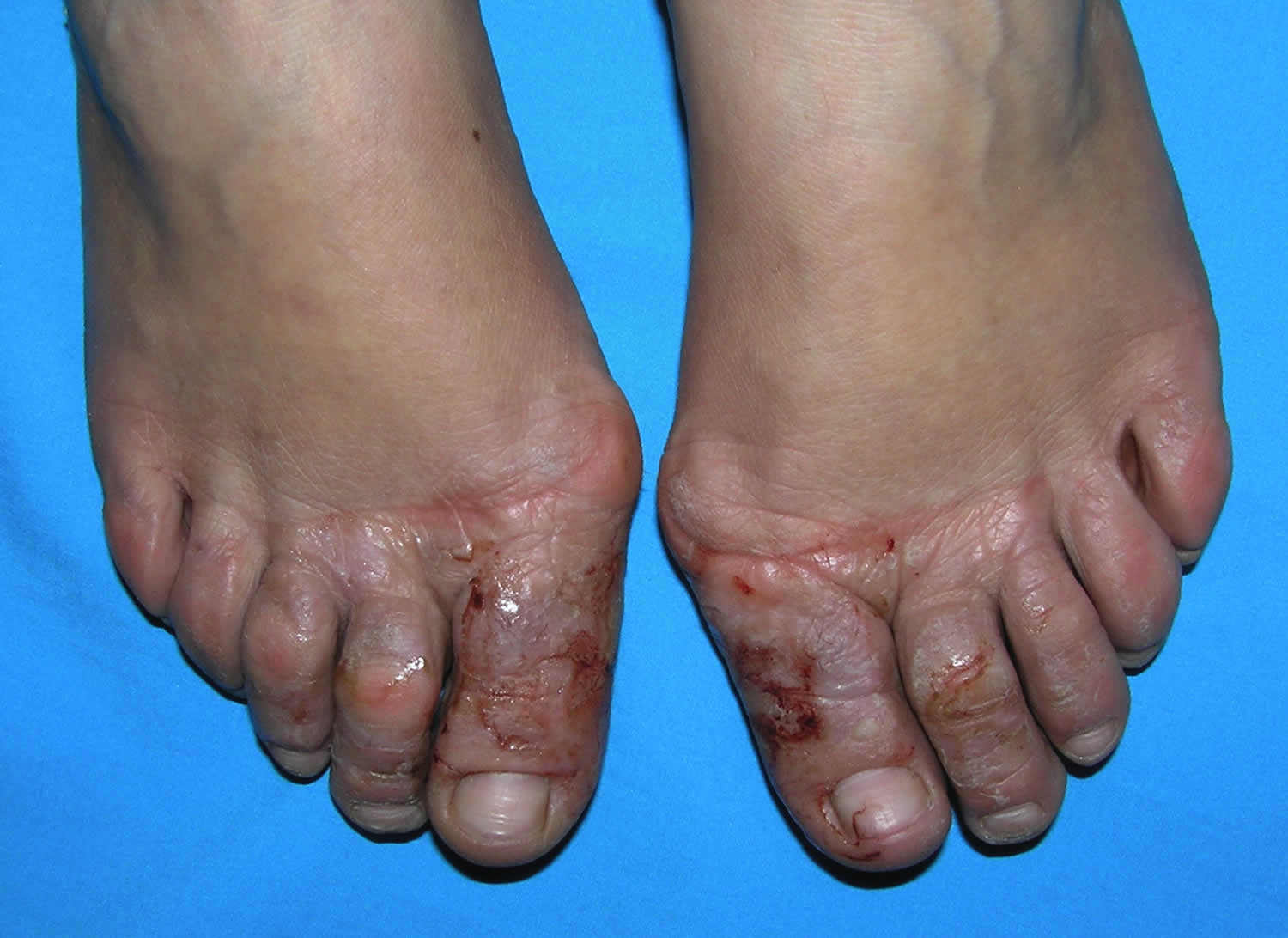Shoe contact dermatitis
Shoe contact dermatitis is defined as skin manifestations on the feet caused by the wearing of shoes, boots and sandals. Shoe contact dermatitis is a type of allergic contact dermatitis that often occurs because the skin on your feet reacts to particular substances (allergens) found in your footwear. Many different products and chemicals are used in the manufacture of footwear. Allergy may be due to the chemicals found in the material that the footwear is made from, e.g. leather or rubber, from glues used to hold the shoe together, or from decorations applied to the shoe.
Allergic contact dermatitis is a type 4 or delayed-type hypersensitivity response by an individual’s immune system to a small molecule (less than 500 daltons), or hapten, that contacts a sensitized individual’s skin 1. The initial or induction phase of allergic contact dermatitis occurs when the hapten combines with a protein to form a complex that leads to the expansion of an allergen-specific T cell population; the name for this process is sensitization. During the elicitation phase, re-exposure to the antigen leads to the development of dermatitis. Allergic contact dermatitis accounts for 20% of contact dermatitis and allergens differ greatly based upon geography, personal habits, and hobbies, and often, the types of preservatives that are legally permissible, such as quaternium-15 in the United States but not Europe 2.
Figure 1. Shoe dermatitis
Shoe contact dermatitis causes
Many different products and chemicals are used in the manufacture of footwear. Allergy may be due to the chemicals found in the material that the footwear is made from, e.g. leather or rubber, from glues used to hold the shoe together, or from decorations applied to the shoe.
Freeman 3 reported that rubber was the most common cause of allergic shoe dermatitis (44%) in her cohort, followed by potassium dichromate (24%), 4-tert-butylphenol formaldehyde resin (PTBFR) (20%), and colophonium (9%). Another retrospective study, conducted by Warshaw et al. 4, evaluated 109 patients with allergic shoe dermatitis from the North American Contact Dermatitis Group between 2001 and 2004, and analysed the frequency of causative allergens. Rubber compounds accounted for the highest percentage of allergies (40%), followed by adhesives (33%) and leather chemicals (20%). 4-tert-butylphenol formaldehyde resin (PTBFR) was the commonest allergen (25%).
Rubber
- Rubber accelerators are chemicals used to speed up the manufacturing process of rubber. Nearly all rubber compounds contain rubber accelerators.
- Rubber box toe shoes/boots are the most common cause of shoe dermatitis
- Other footwear made with rubber include sneakers, tennis shoes, slippers, boots, jandals or flip-flop sandals
- Rubber cement is used in joining shoe uppers, the outer leather and linings
Leather
- Dimethyl fumarate (DMF) is a potent allergen found in sachets found in shoe boxes 5. It prevents mold growth of leather shoes but in doing so permeates the leather. Lamas et al. 6 warned that many sachets named “Silica gel” contain also significant amounts of dimethyl fumarate (DMF). In March of 2009 the European Commission published a communication 7 that banned importation of products contaminated with DMF such as sofas, shoes, and toys (maximum limit of 0.1 mg/Kg). They proposed that contaminated products in the marketplace should be seized; consumers should be informed of the risks.
- Chromates such as potassium dichromate used in leather tanning can be a problem particularly if the feet perspire as sweat leaches out the chromates
- Formaldehyde is used in the tanning of white leather shoes in ‘white kid’ and ‘new bucks.’
Other causes
- Dyes, particularly paraphenylenediamine
- Glues such as para-tertiary butylphenol formaldehyde resin and colophony
- Metal components such as buckles or decorations that come into direct skin contact. Nickel and cobalt are common allergens.
Shoe contact dermatitis prevention
If you suffer from shoe contact dermatitis the best way to prevent any problems is by avoiding all footwear that contains the allergen you are sensitive to.
Some steps you can take to reducing shoe contact dermatitis reactions include:
- Controlling foot perspiration using antiperspirants
- Wear vegetable-tanned shoes
- Replace rubber insoles with a foam sole, e.g. urethane foam
- Air shoes regularly and do not keep them boxed up with dimethyl fumarate (DMF) sachets.
Your dermatologist may have further specific advice, particularly if you are highly sensitive to particular allergens.
Shoe contact dermatitis symptoms
Shoe contact dermatitis usually begins on the top surface of the big toe and spreads to the upper surfaces of the foot. Dermatitis may also be found on the sole, the side of the feet and heels and the legs.
Symptoms of contact allergic dermatitis may include swelling, redness, blisters or cracks in the skin, burning, itchiness and pain. The allergy can develop over a long period as the skin on the feet is repeatedly exposed to a certain allergen found in the shoe. However, it is not unusual to suddenly become allergic to a substance after months or years of exposure.
Shoe contact dermatitis diagnosis
The diagnosis of allergic contact dermatitis is usually established by a combination of history and physical examination, clinical presentation, and a positive patch test. However, often shoe contact dermatitis is difficult to diagnose as there are some other diagnoses that need to be ruled out. These include:
- bacterial infection
- fungal infection (tinea pedis, athlete’s foot)
- atopic dermatitis
- irritant contact dermatitis due to occlusion, moisture and friction
- Juvenile plantar dermatosis
- pompholyx
- psoriasis
- lichen planus
- allergic contact dermatitis caused by something other than shoes (e.g. sock fabric, cosmetic product).
Diagnosis by performing special allergy tests (patch tests) may involve testing against some different chemicals due to the many potential allergens that may be present in the shoe. Patch testing with portions of the patient’s shoes, alongside a shoe ‘screening tray’ of common additives and chemicals is essential in making a correct diagnosis.
If further evaluation is required, a skin biopsy of an affected area of skin will typically demonstrate spongiosis. However, this finding is unlikely to facilitate differentiation of allergic contact dermatitis from other eczematous dermatologic disorders 8.
Shoe contact dermatitis treatment
The only definitive treatment of allergic contact dermatitis is the identification and removal of the offending agent, and all patients with suspected or confirmed allergic contact dermatitis should be advised of this. Shoe contact dermatitis should clear rapidly once the offending allergen is removed. This will mean not being able to wear the offending shoes ever again unless the allergen can be removed. For example, allergy to a nickel buckle could be resolved by replacing with a non-nickel buckle. Allergy to chromate in leather can be avoided by choosing vegetable tanned leather items.
Over-the-counter creams and ointments containing mild topical steroids, such as hydrocortisone, may be used to help control itching, swelling, and redness. In more severe cases, a prescription topical steroid may be required, as well as antibiotic medication if the skin becomes blistered, painful and infected.
In cases of chronic or recalcitrant allergic contact dermatitis, use patch testing to identifying the causative agent 9. Successful patch testing requires several components: choice of appropriate chemicals for testing, a positive patch test to relevant allergens, and patient counseling of patch test results. Additionally, the North American Contact Dermatitis Group Contact Allergen Management Program can be utilized to generate a “safe list” of products that do not contain the patient’s allergens. In the case where allergens are unavoidable, systemic therapy may be necessary 10.
References- Divkovic M, Pease CK, Gerberick GF, Basketter DA. Hapten-protein binding: from theory to practical application in the in vitro prediction of skin sensitization. Contact Dermatitis. 2005 Oct;53(4):189-200.
- Lazzarini R, Mendonça RF, Hafner MFS. Allergic contact dermatitis to shoes: contribution of a specific series to the diagnosis. An Bras Dermatol. 2018 Sep-Oct;93(5):696-700.
- Freeman S. Shoe dermatitis. Contact Dermatitis. 1997 May;36(5):247-51. https://doi.org/10.1111/j.1600-0536.1997.tb00211.x
- Warshaw EM, Schram SE, Belsito DV, DeLeo VA, Fowler JF Jr, Maibach HI, Marks JG Jr, Mathias CG, Pratt MD, Rietschel RL, Sasseville D, Storrs FJ, Taylor JS, Zug KA. Shoe allergens: retrospective analysis of cross-sectional data from the north american contact dermatitis group, 2001-2004. Dermatitis. 2007 Dec;18(4):191-202. doi: 10.2310/6620.2007.06047
- Santiago, F., Andrade, P., Gonçalo, M., Mascarenhas, R., & Figueiredo, A. (2010). Allergic contact dermatitis to shoes induced by dimethylfumarate: A new allergen imported from China. Dermatology Online Journal, 16(3). Retrieved from https://escholarship.org/uc/item/1n56g6cf
- Lamas JP, Sanchez-Prado L, Garcia-Jares C, Llompart M. Determination of dimethyl fumarate in desiccant and mouldproof agents using ultrasound-assisted extraction gas chromatography with electron-capture detection. J Chromatogr A. 2009 Jul 24;1216(30):5755-8. doi: 10.1016/j.chroma.2009.06.028
- Commission Decision of 17 March 2009 requiring Member States to ensure that products containing the biocide dimethylfumarate are not placed or made available on the market. Official Journal of the European Union 2009 March;52:32-4.
- Esser PR, Martin SF. Pathomechanisms of Contact Sensitization. Curr Allergy Asthma Rep. 2017 Nov 11;17(12):83.
- Simonsen AB, Foss-Skiftesvik MH, Thyssen JP, Deleuran M, Mortz CG, Zachariae C, Skov L, Osterballe M, Funding A, Avnstorp C, Andersen BL, Vissing S, Danielsen A, Dufour N, Nielsen NH, Thormann H, Sommerlund M, Johansen JD. Contact allergy in Danish children: Current trends. Contact Dermatitis. 2018 Nov;79(5):295-302.
- Jaulent C, Dereure O, Raison-Peyron N. Contact dermatitis caused by polyacrylamide/C13-4 isoparaffin/laureth-7 mix in an emollient cream for atopic skin. Contact Dermatitis. 2019 Jul;81(1):70-71.






